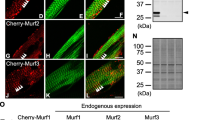Abstract
During postnatal development, the subunit compositions of the 6-phosphofructo-l-kinase isozyme pools of heart and skeletal muscle are known to change. The isozyme pools from fetal muscle were composed of the L-type (60%), and M-type (36%) and C-type (4%) subunits and the isozymes from fetal and early neonatal heart contain nearly equal amounts of all three subunits. During postnatal development of both tissues, the proportion of the M-type subunit increases until it is the only type present in adult muscle and the major subunit in adult heart (7507o). The isozyme pool from fetal muscle exhibit a decreased affinity for fructose-6-P and a greater susceptibility to ATP inhibition compared to the M-rich isozymes which are subsequently present. The isozyme pools from fetal and early neonatal heart, if compared to the M-rich isozymes which are present later during heart development and to the fetal muscle isozymes, exhibited the least affinity for fructose-6-P and the greatest susceptibility to ATP inhibition. Comparison of the isozyme pools containing little or no C-type subunit with those from fetal and early neonatal heart clearly indicates that the presence of substantial levels of the C-type subunit imposed a decreased ability for fructose-2,6-P2 to both lower affinity for fructose-6-P and antagonize sensitivity to ATP inhibition. Although still not thoroughly appreciated, it appears that the changing nature of the isozyme pools in these tissues permits regulation of glucose metabolism in a manner which allows efficient utilization of nutritional opportunities and which adequately meets the energy requirements of each tissue at different stages of development.
Similar content being viewed by others
Abbreviations
- PFK:
-
6-phosphofructo-l-kinase
- fructose-6-P:
-
D-fructose-6-phosphate
- fr-t_ose-2,6-P2 :
-
D-fructose-2,6-bisphosphate
References
Bergmeyer HU (ed) Methods of Enzymatic Analysis, 2nd Ed., Vol. 4, Verlag Chemie International, Deerfield Beach, Florida, 1974, pp. 2271 and 2294
Dunaway GA: A review of animal phosphofructokinase isozymes with an emphasis on their physiological role. Mole Cell Biochem 52:75–91, 1983
Dunaway GA, Kasten TP: Nature of the subunits of the 6phosphofructo-l-kinase isozymes from rat tissues. Biochem J 242:667–671, 1987
Dunaway GA, Kasten TP: Characterization of the rat heart 6-phosphofructo-l-kinase isozymes. J Mol Cell Cardiol 17:947–957, 1985
Dunaway GA, Kasten TP: Nature of the rat brain 6phosphofructo-t-kinase isozymes. J Biol Chem 260:4180–4185, 1985
Dunaway GA, Kasten TP, Nickols GA, Chesky J: Regulation of skeletal muscle 6-phosphofructo-l-kinase during aging and development. Mech Age Dev 36:13–23, 1986
Dunaway GA, Kasten TP, Kolm P: Alteration of 6phosphofructo-l-kinase isozyme pools during heart development and aging. J Biol Chem 261:17170–17173, 1986
Foe LG, Kemp RG: Isozyme composition and phosphorylation of brain phosphofructokinase. Arch Biochem Biophys 228:503–511, 1984
Vora S, Seaman C, Durham S, Piomelli S: Isozymes of human phosphofructokinase: identification and subunit structural characterization of a new system. Proc Natl Acad Sci, USA 77:62–66, 1980
Kahn A, Meienhofer MC, Cottreau D, Lagrange J-L, Dreyfus J-C: Phosphofructokinase (PFK) isozymes in man. I. Studies of adult human tissues. Hum Genet 48:93–108, 1979
Close R: Dynamic properties of mammalian skeletal muscle. Physiol Rev 52:129–197, 1972
Barrie S, Harris P: Myocardial enzyme activities in guinea pigs during development. Am J Physiol 233:H707-H710, 1977
Cox SJ, Grunberg DL: Metabolite utilization by isolated embryonic rat hearts in vitro. J Embryol Exp Morph 28:235–245, 1972
Hoerter IA, Opie LH: Perinatal changes in glycolytic function in response to hypoxia in the incubated or perfused heart. Biol Neonata 33:144–161, 1978
Kasten TP, Naqui D, Kruep D, Dunaway GA: Purification of homeogenous rat phosphofructokinase isozymes with high specific activities. Biochem Biophys Res Commn 111:462–469, 1983
Uyeda K, Furuya E, Richards CS, Yokoyama M: Fructose-2,6-P2, chemistry and biological function. Mole Cell Biochem 48:97–120, 1982
Hue L, Blackmore PF, Shikama H, Robinson-Steiner A, Exton JH: Regulation of fructose-2,6-bisphosphate content in rat hepatocytes, perfused hearts and perfused hind limbs. J Biol Chem 257:4308–4313, 1982
Author information
Authors and Affiliations
Rights and permissions
About this article
Cite this article
Dunaway, G.A., Kasten, T.P. Physiological relevance of the changing subunit composition and regulatory properties of the 6-phosphofructo-1-kinase isozyme pools during heart and muscle development. Mol Cell Biochem 87, 71–77 (1989). https://doi.org/10.1007/BF00421084
Received:
Accepted:
Issue Date:
DOI: https://doi.org/10.1007/BF00421084




